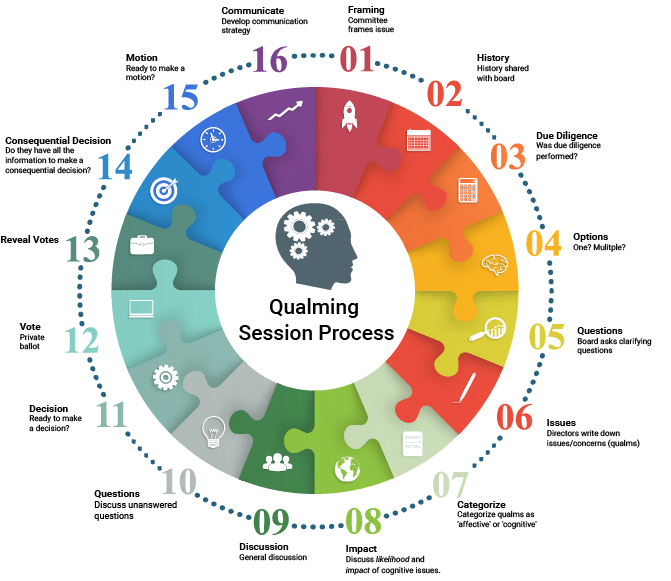Mark T. Engle, FASAE, CAE
Mark T. Engle, D.M., FASAE, CAE, is principal at Association Management Center, based in Chicago.

Board members often feel the strain of justifying a consequential decision to each other, to past leaders, and to members. A technique called qualming can help put your board at ease so they can make the best decisions.
Good decision making is essential to associations, but not every board member has experience or training in this crucial ability. Consequential decisions—the type we know boards should focus on—have high stakes or visibility that may paralyze board members who fear the consequences if they fail to make the best choice.
The problem can play out in scenarios like these:
Scenario 1: A critical decision comes before the board. Past leaders, current industry icons, and other prominent figures in the community have shared their thoughts on what has become an emotional issue. The board's discussion focuses on how to avoid upsetting these leaders, and it is headed toward making an unwise decision due to undue influence by this well-meaning but uninformed group.
Scenario 2: The board must decide whether to discontinue a long-running passion project of a past leader that no longer fits the association's mission. Staff and several volunteer leaders are convinced of the merits of their recommendation, but they are concerned that emotional factors stand in the way of the board making a decision to end the project.
Bad decisions by boards are often made based on an argument's emotional elements instead of its cognitive ones because members aren't prepared to manage the emotional aspects of an issue. Association Management Center (AMC) is often asked to help boards make wise and consequential decisions, so I was intrigued when I found a brief reference to a qualming session made by leadership expert Warren Bennis.
Qualming fits under the umbrella of active dissent. Kinder than conflict management, active dissent encourages constructive conflict to increase thoughtful discussion.
Although a prolific author, Bennis wrote little about qualming, which he characterized as an opportunity to encourage participants to voice the ways they believe an effort can fail. If this sounds counterproductive, consider how much we're learning about the role of debate in the boardroom. How can we encourage board members to constructively challenge positions without being seen as heretics? Qualming is a technique that invites everyone to play a constructive role.
Patricia Blake, FASAE, CAE, CEO of the American Society for Gastrointestinal Endoscopy, provided the perfect opportunity to field-test a qualming session when ASGE's leaders were faced with a strategic decision involving millions of dollars. Such high stakes can make any volunteer leader sweat. Blake asked AMC to help her board navigate this difficult discussion by linking our research on conflict and decision making with practical application.
After helping the ASGE board conduct a self-assessment, we built a development session to show the board the difference between the organization's current level of performance and the level they desired to achieve. Then, we held a qualming session to help the board make a wise decision on the high-stakes issue.
But first, we needed to figure out exactly what a qualming session was. After all, Bennis hadn't offered any details.
I created a 16-step process (see below) that would encourage board members to voice their fears, while also revealing the cognitive elements that would validate or counter those worries. Qualming fits under the umbrella of active dissent. Kinder than conflict management, active dissent encourages constructive conflict to increase thoughtful discussion, and it ensures that emotional elements don't torpedo the cognitive elements that lead to high-quality decisions.
Figure 1: Qualming Session Process

We worked through the 16 steps, starting by identifying board members' likely cognitive concerns about making this decision. Blake and her team did extensive research and provided information to address these elements early in the process. The board discussed each concern based on its likelihood of occurring and potential severity. Staff provided facts to help the board correctly assess their concerns.
For instance, one fear was that ASGE would suddenly have an urgent need for the money the board was considering spending. Blake had documentation showing that ASGE hadn't tapped savings in years, even during the 2008 economic collapse, to illustrate why this fear shouldn't be a major factor in the decision.
After dealing with the 10 to 12 cognitive elements, the board turned to its purely emotional fears. By the time they were down to these last qualms, the conclusion was evident, so the board didn't need to spend much time discussing them.
Now the board was ready to make a consequential decision, one that wouldn't be derailed by emotions. The emotional aspect of the argument wasn't ignored or swept under the rug; instead, it was openly acknowledged and managed. The decision was unanimous, as was board members' confidence in having made the right decision, and it was now time to focus on how to communicate the decision.
Emotions can kill the strongest arguments and lead to poor decisions. A qualming session is one tool to help manage, rather than ignore, emotions.